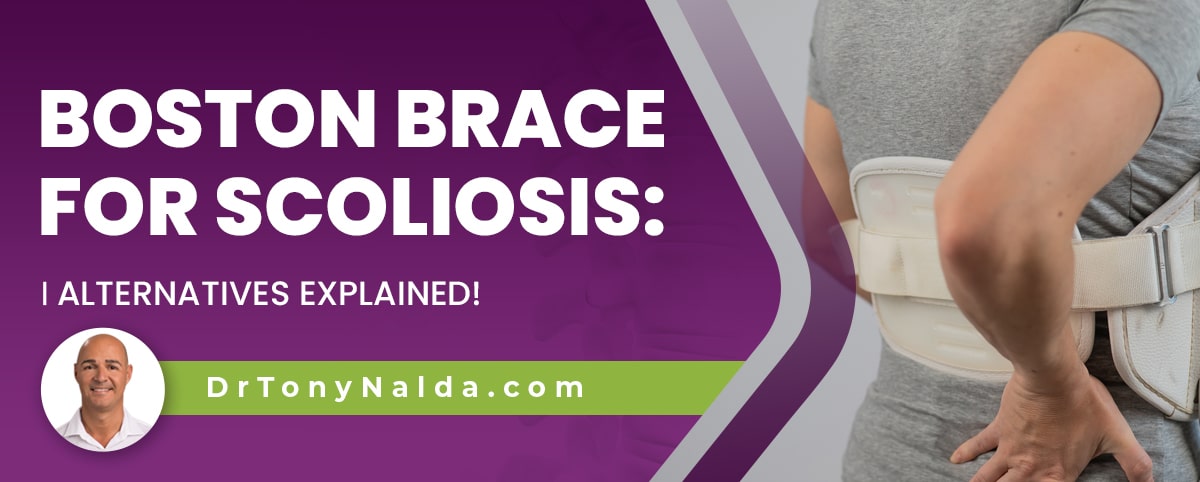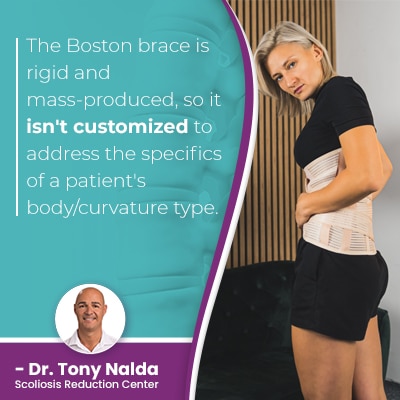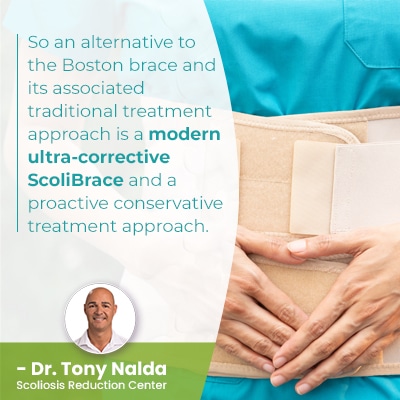Boston Brace for Scoliosis: Alternatives Explained!

Bracing is a common facet of scoliosis treatment, particularly in childhood scoliosis as growing spines are more malleable. A scoliosis brace wraps around the torso under the arms and extends to the waist. The biggest challenge to scoliosis bracing is compliance; braces can't be effective unless worn precisely as prescribed, and for many, bracing can be uncomfortable and restrictive.
Different types of scoliosis braces are used in treatment, and the Boston brace is the most commonly used brace in traditional treatment. The Boston is associated with a number of cons, which modern corrective bracing addresses.
As the prescription of a scoliosis brace is based on the type of treatment approach it's aligned with, let's start by exploring the two main treatment approaches.
Table of Contents
What is Scoliosis?
Scoliosis causes the spine to bend unnaturally to the side and rotate, and as a progressive condition, the nature of scoliosis is to get worse over time.
Scoliosis progressing means the size of the unnatural spinal curve is increasing, as are the condition's effects.
Scoliosis is a structural spinal condition, meaning it involves a structural abnormality within the spine itself, so scoliosis treatment has to primarily impact the condition on a structural level.
Scoliosis introduces a lot of uneven forces to the spine, its surrounding muscles, nerves, and the entire body.
The spine has three main spinal sections, and scoliosis can develop in any one section, or in more than one as a combined scoliosis: the cervical spine, thoracic spine, and the lumbar spine.
When it comes to the effects of scoliosis, in most cases, it's the area of the body immediately surrounding the affected spinal section that's going to feel the majority of the effects.
Following a diagnosis of scoliosis, the most important decision to be made is the type of treatment approach to commit to, but what patients need to understand is that different types of treatment will affect the spine differently.
Traditional Scoliosis Treatment
Traditional scoliosis treatment tends to funnel patients towards spinal fusion surgery because the approach isn't proactive.
Traditional treatment does little to prevent curve progression, but is more about reacting with surgery when/if a patient's scoliosis progresses and becomes severe.
Traditional scoliosis treatment has the goal of stopping scoliosis from progressing, but this is different from working towards corrective results.
In fact, the only treatment options applied prior to spinal fusion involve the prescription of a traditional scoliosis brace, the most common of which is the Boston brace.
Boston Brace for Scoliosis
 The Boston brace is the most commonly prescribed brace in traditional scoliosis treatment.
The Boston brace is the most commonly prescribed brace in traditional scoliosis treatment.
Boston orthotics were designed in the '70s, and its design has changed little over the years, despite learning more about the condition and brace efficacy.
The Boston brace is rigid and mass-produced, so it isn't customized to address the specifics of a patient's body/curvature type.
Through a 3-point pressure system, strategically placed pads apply pressure along certain points of the unnatural spinal curve, squeezing the spine into a straighter alignment, but a scoliotic spine is already weak and exposed to a number of uneven forces, and squeezing is associated with weakening the spine over time.
The Boston brace doesn't address the condition's rotational component, so it only addresses the unnatural spinal curve in two dimensions when it's a complex 3-dimensional condition.
The biggest challenge to scoliosis bracing is compliance; a brace has to be worn exactly as prescribed to be effective, and the most common age group affected by scoliosis isn't exactly known for transparency and compliance: adolescents between the ages of 10 and 18.
So the Boston brace is limited in its potential efficacy due to compliance challenges, its squeezing design, and the fact that it doesn't address the true 3-dimensional nature of the condition, ignoring its rotational component.
The squeezing pressure can cause skin irritation, rib cage pain, breathing issues, and activity restrictions.
But what's more concerning is the traditional treatment approach that Boston is a part of because it does little to prevent progression, unlike conservative treatment, that is crafted around a proactive treatment response.
Traditional treatment is more reactive than proactive because it doesn't work towards preventing progression, but is more about responding to it with surgical intervention.
Conservative Scoliosis Treatment
Conservative scoliosis treatment offers patients a non-surgical treatment alternative, and here at the Scoliosis Reduction Center®, maximal curve correction is possible with early detection and intervention.
There are no treatment guarantees, but the sooner treatment is started, the better because as scoliosis only gets more complex to treat as it progresses, it makes sense to work towards preventing increasing condition severity.
Through starting treatment immediately following a diagnosis, cases will be at their mildest, the spine will be the most flexible and responsive to chiropractic care, and physical therapy and scoliosis exercises work towards increasing the strength and balance of the spine's surrounding muscles; this means more support and stability for the spine.
The ScoliBrace for Scoliosis: Boston Brace Alternative
The ScoliBrace is part of a modern conservative scoliosis treatment approach and is ultra corrective.
The ScoliBrace represents the culmination of what we've learned about scoliosis and brace efficacy over the years; in addition, the ScoliBrace addresses the shortcomings of boston braces.
The ScoliBrace is custom designed to address the specifics of each patient's body/curvature type, and this ensures the brace fits as comfortably as possible, improving the issue of compliance; it is also a flexible and softer brace that can easily be concealed under clothes.
Corrective bracing applies corrective forces by pushing the spine, not squeezing it, and this doesn't strain and weaken the spine as a squeezing brace can.
To make a scoliosis brace work, the treatment needs to be combined with other corrective treatment disciplines, and this is part of the multifaceted treatment approach that characterizes non-surgical treatment.
So in addition to the ScoliBrace, chiropractic care, physical therapy, and rehabilitation will also be applied.
So, an alternative to the Boston brace and its associated traditional treatment approach is a modern ultra-corrective ScoliBrace and a proactive conservative treatment approach.
As you can see, how a diagnosis of scoliosis is responded to with treatment is key.
Diagnosing Scoliosis
 Diagnosing scoliosis isn't always easy, particularly in children for whom the condition isn't commonly painful; scoliosis doesn't become a compressive condition until skeletal maturity has been reached, when uneven pressure can cause back pain, muscle pain, and pain that radiates into the extremities due to nerve compression.
Diagnosing scoliosis isn't always easy, particularly in children for whom the condition isn't commonly painful; scoliosis doesn't become a compressive condition until skeletal maturity has been reached, when uneven pressure can cause back pain, muscle pain, and pain that radiates into the extremities due to nerve compression.
And when mild, scoliosis isn't associated with functional deficits, and even postural changes that affect children can be subtle and difficult for anyone, other than an expert trained in what to look for, to detect.
Postural changes like uneven shoulders and hips are often the earliest signs of scoliosis in children.
Diagnosing scoliosis involves a combined physical examination and X-ray results; an X-ray is needed to confirm the spine's rotational component and a patient's Cobb angle measurement.
Condition Severity
Cobb angle determines condition severity, and scoliosis ranges widely in severity from mild scoliosis to moderate scoliosis, severe and very severe scoliosis.
As such a highly-variable condition, part of diagnosing scoliosis includes further classifying conditions based on key patient/condition variables: patient age, condition severity, curvature location, and condition type.
Type is determined by causation, and the most common type of scoliosis to affect all ages is idiopathic scoliosis.
Scoliosis patients need to be informed; they have to choose between facing invasive spinal surgery, or attempting to correct the scoliosis with non-surgical treatment.
Conclusion
The boston brace for scoliosis is limited in its potential efficacy, not just due to its outdated design, but also because of the treatment approach it's part of.
The Boston brace is the most commonly prescribed thoracic, lumbar sacral orthosis brace in traditional treatment, and the Boston is the only treatment applied prior to recommending spinal fusion surgery in severe cases.
Traditional treatment doesn't have a strategy for treating mild scoliosis so commonly recommends watching and waiting for continued progression, but as all cases are virtually guaranteed to progress at some point, this can mean wasting valuable treatment time.
As growth spurts trigger progression, being proactive with treatment is particularly important when treating scoliosis in growing children.
Non operative treatment options for scoliosis include chiropractic care, physical therapy, corrective bracing, rehabilitation, and a scoliosis brace, particularly when treating childhood scoliosis as growing spines are more malleable and responsive to bracing.
Additional scoliosis braces include the Charleston bending brace (nighttime bracing), which is worn during sleeping hours when the brace doesn't have to account for movement; the Providence brace; the Rigo Chateau brace; and the Milwaukee brace.
Here at the Center, as part of correcting scoliosis, I favor the ultra-corrective potential of the ScoliBrace as an alternative to traditional bracing and treatment.
Dr. Tony Nalda
DOCTOR OF CHIROPRACTIC
After receiving an undergraduate degree in psychology and his Doctorate of Chiropractic from Life University, Dr. Nalda settled in Celebration, Florida and proceeded to build one of Central Florida’s most successful chiropractic clinics.
His experience with patients suffering from scoliosis, and the confusion and frustration they faced, led him to seek a specialty in scoliosis care. In 2006 he completed his Intensive Care Certification from CLEAR Institute, a leading scoliosis educational and certification center.
About Dr. Tony Nalda
 Ready to explore scoliosis treatment? Contact Us Now
Ready to explore scoliosis treatment? Contact Us Now





